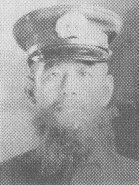
IJN Commander Toyoaki Horiuchi
The city of Menado is situated at the Minahassa Peninsula in the north of Celebes Island and it is today an important trade harbor in Indonesia.
The Menado garrison ["Troepencommando Menado"] numbered approximately 1,500 men and officers;
- The commanding officer (Major B.F.A. Schilmöller) and his staff
- Compagnie Menado; a native unit 188 men strong. This company was reinforced with a Vickers machine-gun section and was commanded by Captain W.F.J. Kroon.
- Mobiele Colonne; this mobile unit had about 45 men and was commanded by Sergeant-Major A.J. ter Voert. It was intended to be used against Japanese paratroopers and had three so called "overvalwagens" (armoured cars equipped with Madsen light machine-guns) available.
- Reserve Korps Oud Militairen (RK); this unit was made up from retired KNIL personnel with an average age of over 50 and was commanded by Captain W.C. van den Berg. It had 5 companies:
• A Company (8 brigades) commanded by 1st Lieutenant A.O. Radema
• B Company (8 brigades) commanded by 1st Lieutenant W.G. van de Laar
• C Company (8 brigades) commanded by 1st Lieutenant H. Fucher
• D Company (8 brigades) commanded by 1st Lieutenant J.G. Wielinga
• E Company (3 brigades) commanded by Sergeant Maliëzer
- Kort Verband Compagnie (KV) of nine brigades under the command of Captain J.D.W.T. Abbink.
- Europese Militie en Landstorm Compagnie (European Militia); about 200 men strong but poorly trained. Commanded by 1st Lieutenant F. Masselink.
- Menadonese Militie Compagnie (Native Militia); about 400 native troops under the command of Captain J.H.A.L.C. de Swert.
- Stadswacht (Home Guard); about 100 men strong and commanded by 1st Lieutenant M.A. Nolthenius de Man. This company did not even have the standard M95 rifles but was armed with old hunting rifles instead.
- Two or three sections Vickers machine-guns; one section was attached to the Compagnie Menado, the other 7 machine-guns were used to defend the airfield.
- Two artillery guns (7.5cm Lang 35 Model 1902); very obsolete field-artillery pieces. Their crews were made up from retired KNIL soldiers.
- Three very old 3.7cm naval guns; placed on trucks, they were used to defend Lake Tondano. They only had an effective range of about 1.000 meters.
With these very limited forces Major Schillmöller had to defend the airfields at Langoan (Menado II) and at Mapanget (Menado I), the naval base at Tasoeka and Menado. If the enemy forces were too strong, he was instructed to regroup his units inland and start a guerrilla war.
- Sasebo Combined Landing Force; this unit from the Imperial Japanese Navy was about 2,500 men strong and under the command of IJN Captain Kunizo Mori. It had two reinforced battalions and support units (engineers, medics etc.). The first battalion was commanded by Major Masanari Shiga and the second battalion by Major Uroku Hashimoto. The Sasebo Combined Landing Force also had a light tank company (equipped with the Model 95 tank) attached to it. It left Davao on January 9th and during the early morning of January 11th landed at two places, at 03:00 at Kema and at 04:00 at Menado.
- 1st Yokosuka Special Landing Force; this parachutist unit from the Imperial Japanese Navy used 519 of its paratroopers to attack Langoan airfield. Its commander was IJN Commander Toyoaki Horiuchi. The 26 transport aircraft from Davao dropped the first 334 troops on January 11th. The next day a further 185 paratroopers were dropped at Langoan.

Major Schilmöller had used his strongest company, the Menado Compagnie, to defend the coast line of Menado Bay. It had the two 7.5cm guns attached to it (one of them was out of action) but these 188 troops had to defend a 2.5 KM wide sector. The Menado Compagnie had its left-flank protected by a small unit (35 men) from the Militia and Landstorm under the command of Lieutenant F. Masselink. The commanding officer of the Menado Compagnie, Captain Kroon, was instructed to fall back to the Tinoör-stronghold, situated some five miles inland, if he was in danger of being cut off by the enemy.
The Japanese landed almost unopposed. Shortly after he heard about the Japanese landings, Captain Kroon came to the conclusion that the situation was hopeless and he ordered his troops to withdraw towards Tinoör. He forgot however to warn Masselink's section and the crew of the 7.5cm gun. The crew of this gun managed to fire a few rounds at the landing enemy but was quickly put out of action. Masselink's section also engaged the landing enemy. He recalls: » I fired at the landing Japanese, realising that I forgot to gave my men the order to open fire. When I finally did so, we forced the enemy to take cover. Then they opened up on us with automatic weapons from a very short distance. ».
Wanting to cover the withdrawing Compagnie Menado, Masselink gave his men the order to fall back towards the Menado-Tomohon road. Here he engaged the enemy again. During this fire-fight, Masselink could clearly hear wounded Japanese soldiers screaming for help. He continued: » While we held our ground, eight trucks passed us and drove towards Tomohon. We kept firing till the last truck was out of sight and then, assuming that we had completed our task, I gave my men the order to withdraw to Tinoör. ».
The Compagnie Menado failed its task completely. When Captain Kroon reached Pineleng, halfway between Menado and Tinoör, he saw that Japanese troops already had occupied this town. Having already lost control of most of his troops, due to poor communication, he gave up the idea to defend the Tinoör-line and went with what was left of his company to Koha instead. Only five brigades of B Company (RK), under the command of Lieutenant van de Laar, were left now to defend Tinoör, but they were reinforced by Masselink's group who managed to reach the line at 07:00. At 10:30 four Japanese tanks appeared, three of them being put out of action by concentrated machinegun fire and a large tree, brought down by the KNIL troops on top of the tanks. The fighting at Tinoör lasted until 15:00 hours when the KNIL troops ran out of ammunition and had to retreat towards Kakaskasen, where they engaged the Japanese again. The 1st Lieutenant W.G. van de Laar wrote about his men: » These old warriors kept their high moral, though they never witnessed a modern battle before and knew fully well that they didn't stand a chance against this formidable enemy. Without ever receiving orders from our commanding officer, we engaged the enemy time after time again. ».
Lieutenant Radema's A Company (RK) was responsible for the defence of Kema. He had two of his brigades placed along the coast line and one at his CP at Ajermadidih, where some sort of defensive position was created with a few pill-boxes. The rest of the company had to defend Mapanget airfield, Likoepang and Bitoeng.
The landings at Kema started at 0300 on 11 January 1942 and were made swiftly. The Japanese transport ships quickly left the area. When Radema heard about the Japanese landing he immediately ordered his troops to regroup at Ajermadidih. When the first Japanese troops, including three tanks, reached Ajermadidih at 09:00, only few of them had actually managed to do so. With the few troops available, Radema tried to stop the Japanese advance. Corporal Pinon Toan, one of the defenders, wrote: » The fighting seemed to last forever. We must have hit a lot of them but they outnumbered us completely and kept on coming. When they reached our position we were ordered by Sergeant Wantania to withdraw. During our retreat we were covered by Sergeant Roemambi and the Privates Iniray and Poesoeng. They kept on firing until their pill-box was destroyed by one of the Japanese tanks. None of them survived but they probably saved our lives. ».
When Radema had to abandon his position at Ajermadidih, he intended to regroup his troops and start a guerrilla war. Due to the fact that many of his native troops deserted, he had to give up this plan.
The defence of Lake Tonadano and the airfield at Longoan fell under the responsibility of the so called Tactical Command Kakas. The commanding officer was Captain W.C. van den Berg. The airfield itself was defended by 41 brigades under the command of 1st Lieutenant J.G. Wielinga. This unit was reinforced with one of the overvalwagens. Wielinga had his CP at the kampong Langoan, where he held 11 brigades back in reserve. The rest of his troops and the overvalwagen were placed at the airfield. Sergeant-Major H.J. Robbemond was in command.
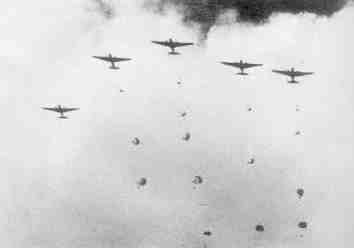 |
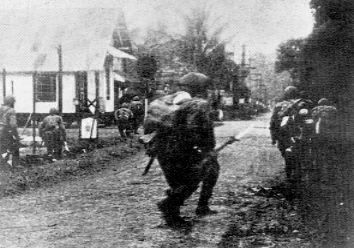 |
Japanese paratroopers jumping from their planes. Photo was taken at Menado, January 1942. |
|
Shortly after 09:00 hours 334 Japanese paratroopers were dropped on and around the airfield. They suffered heavy casualties; according to Japanese sources the commanding officer (Captain Someja), two lieutenants, two NCO's and 30 troops were killed during this action. A further 90 paratroopers were wounded.
Captain van den Berg ordered the two remaining Overvalwagens (under Sergeant-Major Ter Voert) to attack the airfield. The first Overvalwagen (Sergeant Bojoh) managed to reach the airfield but the second (Ter Voert) had its engin shot to pieces and was left immobile. The native soldiers Tauran and Toemoedi kept on firing their machine guns, giving the rest of the crew the opportunity to escape. Though wounded both soldiers managed to escape towards Kakas but Toemoedi was later executed by the Japanese.
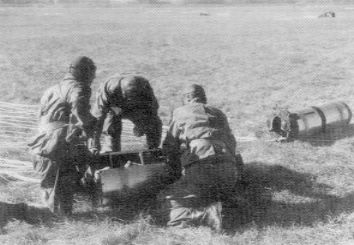
|
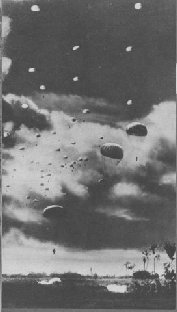 |
The Japanese paratroopers recovering their weapons from equipment containers. The photo was taken at Menado, January 1942. |
Japanese paratroopers over Menado, January 1942 |
Enraged by the heavy losses, the Japanese executed a large number of KNIL POW's. Shortly after the capture of Langoan airfield the D' Company Commander 1st Lieutenant J. Wielinga, Sergeant-Major Robbemond, foerier B. Visscher and nine native soldiers were bayonetted or beheaded. Two more native soldiers died in captivity after they were tortured.
Knowing that the battle was lost, van den Berg ordered his remaining troops to retreat inland and start a guerrilla.
On several places the remaining KNIL forces tried to start a guerrilla against the Japanese invaders. Captain Kroon assembled what was left of the Menado Compagnie (about 50 men) and retreated towards Kembes, hoping to start an active guerrilla from this place. Due to regular desertions by his native soldiers he reached Kembes with only nine men left. Here the group was taken prisoner by the Japanese. All European members, except Kroon himself, were executed at Langoan on January 26th. (Sergeant-Major J.H. Kersten, Sergeant-Major G. Bottinga, Sergeant J.W. Meijer, Sergeant G.H.J. Wissink, Private G.H. Couzijn and Private H.J.A. Rolff).
Sergeant Maliëzer from E-Company did not want to surrender and started a guerrilla with fifteen of his men. On February 8th they attacked a Japanese unit at Kanejan. The fighting lasted the whole day and the Japanese counter-attack failed. Outraged they burned the nearby Kampong and executed five civilians (including two women). On February 12th they came back with a larger force and this time captured Maliëzers group. Maliëzer too was executed at Langoan with twelve of his men. Also executed on this day was another woman, Mrs. Hofman, who took part in the guerrilla because the Japanese had executed her husband, a former knight of the Militaire Willemsorde.
Captain van den Berg's and his group were taken prisoner on February 20th. His group, made up out of pensioners, attacked the Japanese units on several occasions and inflicted heavy casualties. Out of respect for the high average age and fighting spirit, the Japanese commander spared their lives.
Note The ''Reservekorps Oud Militairen'' (RK) consisted of a unit staff and 5 companies (Company A', Company B', Company C' , Company D' and Company E' of retired KNIL personnel who had been recalled to active duty. Companies A', B', C' and D' each had 8 brigades of approximately 15 men each, while Company E' had 3 brigades of 15 men each. Only Company B' had SAW. Total personnel numbered about 525 men.
Note "Kort Verband" (KV) - short term volunteers.
Note There are two postwar battle reports in the files at the SMG. That is the Sectie Militaire Geschiedenis in Den Haag. One report deals with the fighting at the airfield and one deals with the fighting at the roadblock near Menado. The first report states that there was one car at the airfield and that car was captured by the Japanese. The other two cars were on patrol outside the airfield and these cars were involved in the counter attack. The other report tells the story of the fighting at the roadblock in which it cleary speaks of the assistance of an overvalwagen. This meant that the reported total number of cars became 4. There is a memorandum of early 1941 in which the Dutch general staff informes the allies on the defensive measures that are taken in the outer regions (buitengewesten) which claims that 3 overvalwagens are stationed at Menado. Therefore there was always a discussion if the battlereports were correct as they were compiled from memory after the war. There exist a photo of the vehicles at the vehicle maintenance depot at Menado and it shows 3 overvalvalwagens and an, at this moment, unidentified armoured lorry. So that photo solves the whole matter as there were 3 overvalwagens and one armoured lorry of which I haven't decided if it qualifies in a strict definition of the term overvalwagen but must be easely regarded as an overvalwagen. In those days one wasn't that strict in vehicle dessignation - Henry Klom, 11 December 1999.